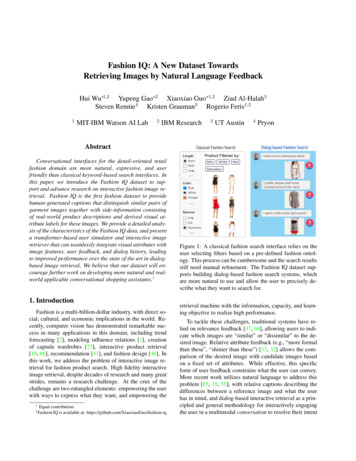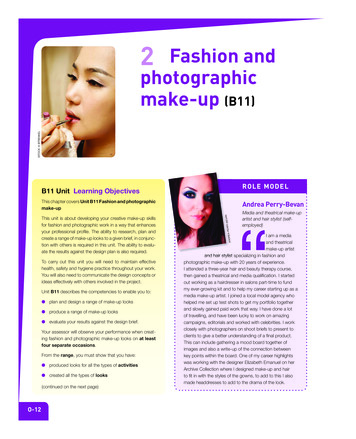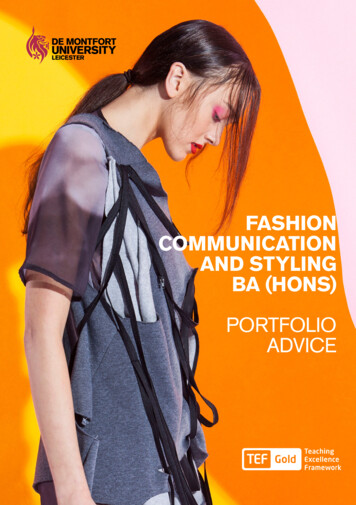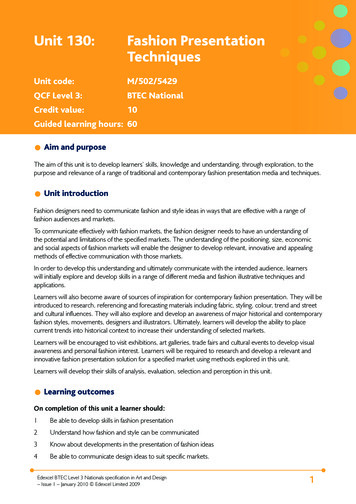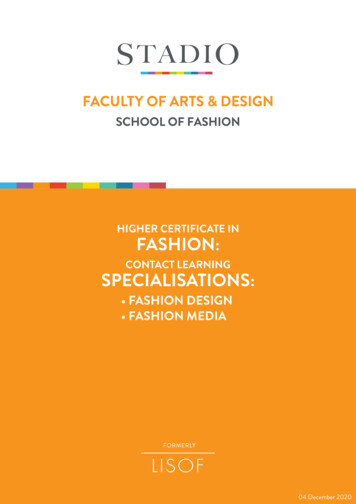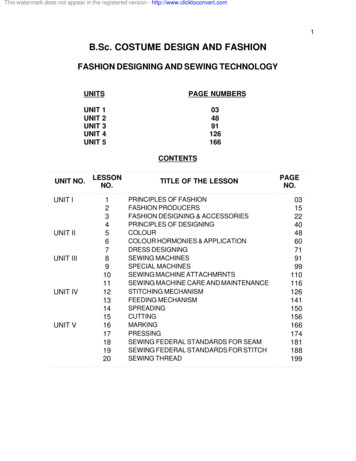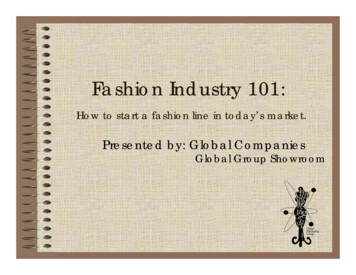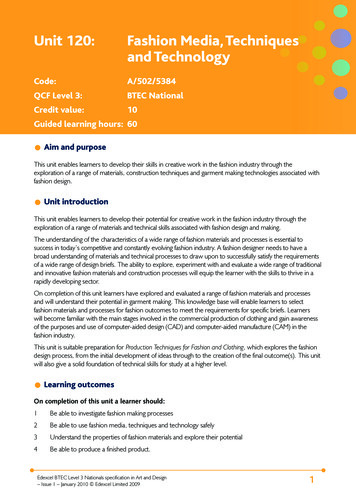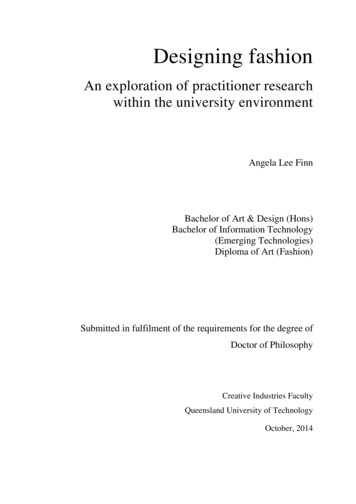
Transcription
Designing fashionAn exploration of practitioner researchwithin the university environmentAngela Lee FinnBachelor of Art & Design (Hons)Bachelor of Information Technology(Emerging Technologies)Diploma of Art (Fashion)Submitted in fulfilment of the requirements for the degree ofDoctor of PhilosophyCreative Industries FacultyQueensland University of TechnologyOctober, 2014
Key wordsfashion, tacit knowledge, tacit knowledge transfer, practitioner knowledge, practice-ledresearch, object analysisPage 2
AbstractThe belief that practitioner knowledge is tacit and cannot be communicated through thetraditional methods of academic writing and journal publication is a problem for the growingnumber of fashion researchers utilising practice-led methodologies. The main reason for this isthat, until recently, the visibility of a discipline has been predominantly defined by academicpublications in the field. One solution has been for researchers to adopt research methodologythat utilises reflective practice to draw out practitioner knowledge and attempt to convert thisknowledge to an explicit form. Alternatively, non-traditional research outputs are nowconsidered equivalent to published research within areas such as art and design. However, acritical mapping of fashion research reveals that practice-led research in fashion is not yetadequately represented by either form of research outcome. This thesis proposes thatcontinuing to focus on the differences between practice-led research and other fashion research,a dychotomic view of practitioner knowledge as either tacit or explicit, and an upward trend inprocess-driven methodology, are limiting the ability for practitioners to contribute to thecontinuing development of fashion as a discipline. The aim of this thesis is to develop aprogressive approach to practice-led research methodology to enable practitioner knowledgeof fashion to become more accessible, transferable and relevant to the emerging methodologyof fashion as a material culture that connects two different ideas of the fashion system as eithermaterial or immaterial.A quantitative and qualitative mapping of fashion research, based on journal publications, nontraditional research outputs and an analysis of practice-led research exegeses, determines thecurrent state of fashion as an emerging discipline. The mapping reveals that dominantmethodologies for existing practice-led research are design methodologies. The results fromthis mapping inform an exploration of the potential for object or artefacts to encapsulate fashionknowledge through the method of object analysis as an object-based methodology used withinother areas of fashion research. The results of this analysis enable the development of twomodels for practice-led fashion research. The first is a model of practitioner knowledge andtheorises tacit knowledge as a hybrid space existing as a relationship between the differenttypes of knowledge that exist in fashion practice. The second is a model of practitioner fashionresearch that incorporates existing design methodology but also responds to emerging fashiontheory and methodology. Both models extend current understanding of fashion practice andcontribute to developing the most effective strategy for communicating practitioner knowledgeof fashion within the university environment.Page 3
Table of contentsKey words . 2Abstract . 3Table of contents . 4List of figures . 7List of tables. 7List of abbreviations . 10Glossary of key terms . 12Statement of Original Authorship . 15Acknowledgments. 16Chapter One: Introduction . 18Background . 21Fashion within the university environment . 23Research design and methodology. 31Positioning statement . 33Thesis structure . 37Conclusion . 39Chapter Two: Fashion Research . 41Fashion education . 43Fashion as a discipline . 46Academic knowledge . 49Fashion as interdisciplinary research . 54Fashion knowledge . 56Knowledge within the fashion industry . 64Adopting methodologies . 69Separation of theory and practice. 74Criticism of fashion research . 86Lack of critical and theoretical research contexts . 91Conclusion . 93Chapter Three: Publication . 96Methods of determining research quality. 97Research mapping . 100Fashion research . 105Data source. 107Page 4
Data collection . 109Results and discussion . 111Non-traditional research outputs . 117Publications and explicit knowledge. 119The role of publication in developing a discipline . 121Fashion theory versus fashion practice . 124Conclusion . 128Chapter Four: Fashion Knowledge . 130The method of object analysis . 133Types of knowledge in museum object. 139Expert knowledge . 141Technical knowledge . 142Practitioner knowledge . 147Knowledge in fashion garments: A case study . 148The Fashion Museum (Bath) — object analysis part I. 150The Powerhouse Museum (Sydney) — object analysis part II . 152Practitioner knowledge in museum fashion objects . 153A framework of practitioner knowledge . 161Physical description of fashion objects . 163Expert industry knowledge . 167Expert design knowledge . 168Tacit knowledge and fashion objects . 169Limitations of object analysis . 170Advantages of object analysis . 172Conclusion . 173Chapter Five: Discussion . 176Proposed model of practitioner knowledge . 178Proposed methodology for practice-led fashion research . 184Practitioner knowledge as fashion knowledge . 192Non-traditional research outcomes in fashion . 196Additional considerations for practice-led research . 208Conclusion . 210Chapter Six: Conclusion . 212Practitioner knowledge . 213Practice-led theory and methodology . 215Advantages of object-based methodology . 217Limitations of object-based methodology . 218Page 5
Publication for practitioner research outcomes . 220Limitations of publication . 223Summary . 224Recommendations for further research . 226Bibliography . 228Appendix 1: PLR Thesis Summary . 248Appendix 2: Summary of articles published in Fashion Practice . 251Appendix 3: Summary of mapping data . 257Appendix 4: NVivo Visualisations from keyword mapping . 264Appendix 5: Summary of non-traditional research outputs in ERA national report 2010 . 266Page 6
List of figuresFigure 2.1 Supply chain complexity (Farrer & Fraser, 2008). 66Figure 2.2 Fashion design 'Business as Usual’ (Finn, 2008b) . 76Figure 2.4 Albert Einstein's workbook showing the workings behind his theory E MC2 . 82Figure 2.5 Leonard Da Vinci’s sketch, referred to as ‘Vitruvian Man’, records andcommunicates an observation and theory of anatomical proportions throughimage alone . 85Figure 2.6 Image of Leonardo Da Vinci’s Sketch Book showing his method ofrecording knowledge with a combination of written text and image. 85Figure 3.1 Results of textual analysis using NVivo software . 107Figure 3.1 Fashion journal publications 1985–2010. Source: ASE . 112Figure 3.2 Fashion journal publications 1985–2010. Source DAAI . 113Figure 3.3 Fashion journal publications — comparison. Source: ASE . 114Figure 3. 4 Overview of publications in similar areas of research within the disciplinesof art and design. Source: DAAI. 115Figure 4.1 Diagrammatic representation of object analysis based on McClung Fleming(1974), Prown (1980, 1982), Steele(1998), Taylor (1998) and Andrade (2004) . 135Figure 4.2 Andrade (2004) Fig. 1 & Fig. 2: Original caption: ‘Front and back of thedress. Courtesy of Hampshire County Council Museums and Archives Service(hereafter HCCMAS) C 1976.31.415.’ . 138Figure 4.3 Andrade (2004) Fig. 3. Design registration for an original gown from theHouse of Louise Boulanger . 140Figure 4.4 Andrade (2004) Fig. 6. Original caption: ‘Details of [the inside of the] dressshowing the superimposition of fabric and overstitched seams (HCCMASC1976.31.415)’ (p.115) . 144Figure 4.5 Chanel Suit Jacket (Item # A8945, 1965) image shows a length of metalchain attached inside the garment just above the level of the finished hemline . 154Figure 4.6 Chanel Suit Jacket (Item # 96/386/5, 1965) a length of metal chain attachedinside a Chanel jacket just above the level of the finished hemline . 154Figure 4.7 Wool tweed fabric used in the Chanel Suit designed in 1965 has a handloomed quality in that it does not look perfectly even in spacing or tension (Item# A8945 Chanel, 1965) . 155Figure 4.8 The jacket lining is ‘quilted’ at intervals of approximately 5 cm to preventthe outer fabric from dropping during extended hanging or wearing (Item #A8945 Chanel, 1965) . 156Figure 4.9 Garment labelling often includes explicit identification of the brand,fabrication and country of production (Karl Lagerfeld [for Chanel], 1991). 157Page 7
Figure 4.10 A measuring tape provides a scale for images of the Balenciaga gown (Item# BATMC 1.09.834 Balenciaga, circa 1950). Adding the element of scale to theimage can also allow comparison to be made between proportions of widths andheights. . 158Figure 4. 11 Sketch of the Jaques Charles gown reconstructed from the method ofobject analysis (Jaques Charles, circa 1948). Sketching is a method of bothunderstanding and recording fashion knowledge encapsulated in object. . 160Figure 4.12 The explicit knowledge recorded on the label of the Jaques Charles dresswas used to search for related information about the designer and business(Jaques Charles, circa 1948) . 162Figure 4.13 A vintage Chanel coat described as having a Chanel label with a labelstitched beneath that reads ‘Cannes Jaques Charles 56. Rue d'Antibes’. It ispossible that this coat was produced for Chanel by Jaques Charles in Cannes. . 163Figure 4.14 The analysis of the Chanel Boutique garment object by a practitioner drawsout expert industry knowledge; in this case, the inclusion of a centre back pleatin the pattern and construction of the garment lining . 168Figure 5.1 Model of practitioner knowledge within the context of fashion (Finn, 2013) . 178Figure 5.2 Proposed model of object-based, practice-led research methodology (Finn,2014) . 185Figure 5.3 Inductive versus deductive approaches (Riello, 2011) . 186Figure 5.4: An experimental theory map of Polanyi’s Theory of Tacit Knowledge(Finn, 2010). 187Figure 5.4: Shirt number 11 [fashion object] documented by Brough (2008, p.127). 203Figure 5.5: Shirt number 37 [fashion object] documented by Brough (2008, p.97). 204Figure 5.6: Design sketches based on a tank top (Evans Mikellis, 2011, p.57) . 205Figure 5.7 Screenshot of Marc Jacobs Autumn/Winter 2010/11 fashion week show onYouTube (http://www.youtube.com/watch?v rw8HuDXZmJI) . 210Page 8
List of tablesTable 2.1 Characteristics of an academic discipline (Krishnan, 2009, p.10). 47Table 3.1 Summary of ERA indicators (ARC, 2008b, pp.4-6). 98Table 3.2 Journal publications based on Bye (2010) . 102Table 3.3 Areas of fashion research based on discipline-specific journal publications . 103Table 3.4 Criteria for data collection . 104Table 4.1 Object analysis November–December 2010. 149Table 4.2 Comparison of construction techniques between two garments from ChanelCouture and Chanel Boutique (Finn, 2010) . 166Table 5.1: A summary of requirements for non-traditional outputs for peer reviewassessment based on ERA submission guidelines (ARC 2011c, p.45) . 199Table 5.2: Summary of individual items for documenting fashion objects or artefacts(Finn, 2013). 207Page 9
List of abbreviationsARCAustralian Research CouncilASEAcademic Search EliteBATMCBath Fashion Museum/Museum of CostumeERAExcellence in Research AustraliaFofRfield of researchHCCMAS Hampshire County Council Museum and ServiceHCIhuman computer interactionNTROnon-traditional research outputOECDOrganisation for Economic Cooperation and DevelopmentPBRFPractice Based Research FundPMPowerhouse MuseumQUTQueensland University of TechnologyR&Dresearch and experimental developmentRAEResearch Assessment ExerciseREFResearch Excellence FrameworkRMITRoyal Melbourne Institute of TechnologyUKUnited KingdomUSAUnited States of AmericaPage 10
UQUniversity of QueenslandUTSUniversity of Technology SydneyPage 11
Glossary of key termsacademic knowledge: Knowledge that exists within the traditional environment of theuniversity, generally expressed in explicit forms of writing and publication.creative practice: The action and process of developing a creative work that includes an artworkor a designed object within a professional environment.creative practitioner: One who utilises creative practice within a professional environment.creative production: Practice-led research that is focused on producing a creative work toenable an individual to have a better understanding of their own creative practice rather thanother types of practice-led research.expert knowledge: Knowledge that is on a deeper level as a result of the personal experiencesof the individual who possesses such knowledge.explicit knowledge: Knowledge that is physically recorded and able to be transferred, the mostcommon form of which, within the university environment, is written text.fashion industry: An international industrial system that extends from intellectualunderstandings of fashion as a human behaviour, a condition of culture, a characteristic ofethnicity, a history of dress, a system of non-written language and a practice of designing,making, manufacturing, marketing and selling fashion garments and accessories.fashion: The tacit or immaterial elements of fashion; that is, what makes somethingfashionable, or of fashionable design, that has yet to be effectively described or defined beyondthese definitions.fashion research: Any type of research related to fashion or the fashion industry.Page 12
fashion researcher: A researcher whose research is related to fashion or the fashion industry.methodology: A system of methods or processes that are used within a particular context; thiscan be confused with research methodology but a design methodology, for example, is a modelof a design process.object-based methodology: Methodology that focuses on the object as a site of recordedknowledge.practice-led methodology: Methodology that focuses on the action of creative practice as themain method of research.practice-led research: Research that utilises creative practice as the main method of researchand presents the results of this practice as the research outcome.practitioner knowledge: Knowledge of creative practice that has a main characteristic ofinvolving first-hand experience. This is similar to explicit knowledge but involves action andpersonal experience of practice. Practitioner knowledge could be explained as expertknowledge of practice but can also be knowledge of practice at an amateur level.practitioner research: Research that utilises creative practice as the main method of inquiry.practitioner research methodology: Methodology that is suited to the purpose of practitionerresearch.practitioner researcher: A practitioner who utilises the methods of practitioner research; apractitioner can also be one who practices within a professional capacity alone.research methodology: A methodology, as a system of methods, used within a particularacademic discipline as a research process or an overarching approach.tacit knowledge: Knowledge that by definition cannot be told.Page 13
technical knowledge: Knowledge that is focused on how to perform a technical operation, suchas construct a pattern for a particular type of collar or cuff, or the steps involved in stitching aseam. Within the fashion industry this knowledge is concerned with procedure and extends tohow to digitise a pattern or how to use Adobe Illustrator .Page 14
QUT Verified Signature
AcknowledgmentsThis thesis has been funded by two separate scholarships that enabled the majority of this studyto be undertaken full time at Queensland University of Technology (QUT). They are theAustralian Post Graduate Award for Doctoral Studies and the QUT Creative IndustriesResearch Scholarship. These scholarships, and all and any additional support from QUT, madeit directly possible for me to take leave without pay from full-time work to undertake thisresearch. It is impossible to acknowledge all of the encouragement and support that I havereceived over the life of this research project but there are a few people who I would like tothank.I would like to thank my parents Shayne and Lee Finn for their constant support for whateverI have wanted to do in life, some things a little more unconventional than others. I know thatwithout them this thesis would not have been possible.Special thanks go to my primary supervisor, Dr Tiziana Ferrero-Regis. She is a highly talentedand knowledgeable person and I have been very fortunate to have her supervision. I know thatI have learned a lot at her shoulder and hope that I can pass on some of this knowledge to mycurrent and future students.This thesis would never have been developed if not for Professor Welby Ings (AucklandUniversity of Technology) and Dr Joan Farrer (University of Brighton), who encouraged meto become involved with research, sharing their passion and understanding for how researchcan contribute to the world in a real way.I would like to thank my AUT colleagues especially Dr Mandy Smith, Kim Fraser and KathrynHardy Bernal for their constant support, encouragement and friendship. Thanks to Dr AlicePage 16
Payne for her support during our time together as students at QUT. I would also like toacknowledge Ms Kerry Davies AE for proofreading and copy-editing the final thesis document.Thanks to Wendy Armstrong and Professor Suzi Vaughan who have been an inspiration to mesince my early involvement with fashion at QUT in 2003. Finally, a special thanks to Mr DaveHarvey for some sound advice given to me at the start of my academic career.Page 17
Chapter One: IntroductionPractitioner knowledge of fashion has been defined as ‘tacit’ knowledge (Aspers,2006; Entwistle, 2009; Kemp, 2007; Kirke & Vionnet, 1998; Weller, 2008). Hencethis knowledge can be neither communicated nor disseminated through traditionalacademic publications. This thesis proposes that, to find appropriate methods for disseminatingpractitioner knowledge of fashion, the determination of the type or types of knowledge thatexists in practice is pivotal. In Australia, New Zealand and the United Kingdom traditionalacademic research is communicated and disseminated through publications whose quality,quantity and impact are evaluated through a peer assessment system. The Excellence inResearch Australia (ERA) scheme managed by the Australian Research Council (ARC) (ARC,2008a, 2008b, 2009, 2011a, 2011b, 2011c, 2011d, 2012) is one such system alongside similarinitiatives such as the Research Excellence Framework (REF) in the United Kingdom and thePractice Based Research Fund (PBRF) in New Zealand. New requirements for presenting nontraditional research outcomes will become mandatory for the next round of ERA qualityassessment to be held in 2015. The option for non-traditional research outputs (NTROs) to beassessed through peer review and more detailed criteria for presenting practice-led research forpeer assessment will affect the assessment of practitioner research. This effectively means thatnon-traditional research outcomes are now considered equivalent to traditional forms ofpublications for the purposes of research assessment. A potential problem exists for practiceled research in fashion if practitioner knowledge is tacit knowledge and publications are notthe best way of communicating research findings. Therefore this thesis responds to thequestions: Is practitioner knowledge in fashion tacit knowledge? And what is the most effectivemethod to communicate practitioner knowledge for the purposes of disseminating practice-ledfashion research? In response, current understandings of practitioner knowledge and practice-Page 18
led research methodology need to be examined to determine the extent of tacit knowledgeinvolved in fashion design practice.The appropriateness of publications as a way of disseminating practice-led research has beenthe topic of much debate within the creative disciplines. Melrose (2005b) and Carter (1984,p.297) suggest that publication is a practice that many academics within the creative disciplinesconsider to be in opposition to artistic development and is not the most appropriate method forcommunicating practitioner research outcomes
Designing fashion An exploration of practitioner research within the university environment Angela Lee Finn Bachelor of Art & Design (Hons) Bachelor of Information Technology (Emerging Technologies) Diploma of Art (Fashion) Submitted in fulfilment of the requirements for the d
